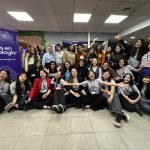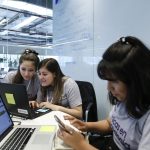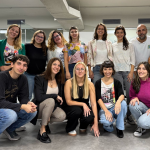What are the Main Factors Influencing the Interest and Participation of Young Women in Technology?
Chicas en Tecnología (CET) has associated with Instituto de Investigaciones Gino Germani to conduct a study on the digital gender gap in young women from Córdoba and Buenos Aires, Argentina.
The research’s purpose is to identify and describe the processes of gender inequality from childhood to youth, as well as characterize the journeys of young women who are highly or little interested in the field, in relation to an academic and/or work future in the STEM (Science, Technology, Engineering, and Mathematics) areas.
The project “Brecha digital de género en chicas adolescentes de Córdoba y Buenos Aires” (Digital Gender Gap in Young Women from Córdoba and Buenos Aires)1 is based on various research methods, which includes interviewing young women to restore the technology appropriation journeys in light of stereotypes and social representation in relation to gender and the technologic field.
At the same time, we included a classification of the interviewees by social class to take into account the intersectionality of the class and gender variables in the digital inequality processes.
The research, which is conducted by Milagros Gimenez and Florencia Deleo, on behalf of CET, analyzes the digital inclusion of people who identify with the female gender starting from the five “C” recognized by Bradbrook and Fisher (2005) as key factors in this process: connectivity, capacity, content, confidence, and continuity.
Some points of inflection were identified in people’s journeys regarding technology, such as the acquisition of their first devices, the influence of role models, the distribution of netbooks at schools, and the impacts derived from the pandemic. At the same time, we saw early challenges emerge in relation to technology, such as the fact that, when girls turn ten years old, they stop using computers for gaming because of a set of factors that make them perceive this field as “manly.”
The research material is part of a chapter included in the last digital book published by CLACSO: “Niñeces y adolescencias en el mundo digital: tendencias y desafíos en pandemia” (Childhood and Adolescence in the Digital World: Trends and Challenges in the Pandemic) (2024)2, which can be read here.
- Project “Brecha digital de género en chicas adolescentes de Córdoba y Buenos Aires.” Director: Matozo, Victoria. Crew: Pablo Molina Derteano, Milagros Giménez, Sheila Amado, Marcelo Boyle, and Florencia Fernández Deleo. Call “Niñas, niños y adolescentes en el mundo digital: características, tendencias y desafíos antes, durante y después de la pandemia” (Children and Adolescents in the Digital World: Characteristics, Trends, and Challenges Before, During, and After the Pandemic) of the National Secretariat of Childhood, Adolescence, and Families (SENAF) and the Latin American Council of Social Sciences (CLACSO).
- Niñeces y adolescencias en el mundo digital: tendencias y desafíos en pandemia. (2024) Chapter: Brecha digital de género en chicas adolescentes de Córdoba y Buenos Aires. Authors: Victoria Matozo, Pablo Molina Derteano, Milagros Giménez, Sheila Amado, Marcelo Boyle, and Florencia Fernández Deleo. Buenos Aires City: CLACSO; Buenos Aires City: National Secretariat of Childhood, Adolescence, and Families (SENAF), 2024. ISBN 978-987-813-714-8.






